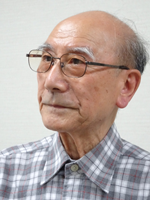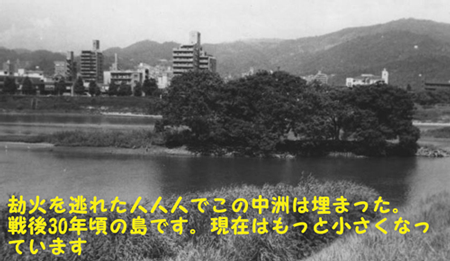Memoir of the A-bombing
Burned by the heat rays of the atomic bomb
Hidetaka Takiguchi
Atomic bomb survivor
registered with our Foundation

Before and after the dropping of the bomb
On August 6, 1945, there were four of us living in our house in Hakushima: my mother, who was 33 years old; me, who would turn five on August 8; my younger sister, who was 10 months old; and my cousin's fiancé. My father was away at war.At around 8 am, my cousin's fiancé said, "I'm going to clean your room, so go outside for a while." So my mother, holding my sister, and I went outside.
At around eight o'clock, the sky was almost cloudless, and the direct rays of the midsummer sun were harshly beating down. I found some shade and was playing there. After a while, I could hear the heavy propeller noise of B-29 bombers. I called out, "Mom, there's planes, I'm going home," and ran back to the house. As I walked in the front door and was about to close the door, there was a flash and I felt a strong pain in my left arm and a slight pain in my left cheek and heel. Immediately after that there was a powerful blast, which blew my little five-year old body away and knocked me unconscious as I hit my head on the edge of the well in the kitchen.
My mother, who was holding my sister, felt an intense pain in her back at the same time as the flash of light. She realized that her blouse was on fire, and hurried to take it off, but her calves and heels were burned. Despite her terrible state, she noticed that her son was not there. She looked for me as she cleaned up the fallen pillars of the house, and saved me. I was still unconscious.
Fleeing to Nakanoshima
The skin on my left arm was peeling and hanging down, and my mother's back was burned with the skin peeling away.We just needed to get away from there, so we climbed up the nearby riverbank with my cousin's fiancé, who was still inside and unharmed, then went through Chojyu-en (a park that was a popular cherry blossom viewing spot until around 1950), and arrived at the bank of the Ota River. There was an island called Nakanoshima in the middle of the river. The river was shallow at the time, so we walked across the river and took refuge at Nakanoshima. When I put my foot in the river, the burn on my heel hurt so bad that I jumped. My mother was even more severely burned, so I think her pain must have been intense. So many people took refuge on Nakanoshima that there was no place to step. In the evening, we crossed the river again and went home, but the house was tilted and we could not go inside, so we spent the night in an air-raid shelter.

Nakanoshima in around 1975. This sandbar was filled with people who had fled the atomic bombing.
Recuperating at my mother's family home
On the third day after the bombing, my mother's brother and my father's sister's husband came to help us. They cleaned up the house, put my mother, my sister and I in a handcart with pots and pans and other tools, and set off from Hakushima for Hiroshima Station. The city that we passed through on the way had turned to burnt-out ruins, and we could see far into the distance. The distinctive smell of the fire afterwards was sickening and horrifying to remember. We arrived at Hiroshima Station, and finally boarded a train amidst crowds of fleeing people. We arrived at Matsunaga City, where my mother's family home was. My mother's parents lived on a farm with a large house, slightly elevated, and we began our recuperation in a large, well-ventilated living room.The burn on my mother's back smelled so bad that my grandparents and uncles, who were taking care of her, kept saying how bad it smelled. A fly may have laid eggs in my mother's back, and the eggs grew into maggots and crawled around on her back, making it itchy. My mother could not get them off by herself, so she had to get others to take them out with a pair of disposable chopsticks. My mother had a persistent high fever of 41 degrees. One day, she lost consciousness: apparently it felt as if she was falling into the bottom of a deep, deep well. She eventually regained consciousness this time, but apparently she thought, "So this is what it means to die."
The burn on my left arm
The skin on my left arm had been burned by the heat rays, and was burned all the way down to my fingertips so that I could not even bend my fingers. To allow my fingers to move freely, they used to insert a cloth soaked in cooking oil between my fingers, but it was extremely painful when they removed the cloth, and I always cried during the treatment. It was worth it, and now I can move my fingers freely. I am grateful for the treatment I received. However, the burned area on my left arm developed into keloid scars and the flesh on the back of my hand in particular became raised, making it difficult to move my wrist. It was especially hard during the cold winter months, when the skin would crack and moving my fingers would cause extreme pain. The cracks became infected and my shirt cuffs were always dirty with pus. My mother, who was worried about my inability to freely move my wrists, found out about the enactment of the Atomic Bomb Survivors Relief Law in 1994. She called the hospital, and I had a skin graft. As a result, I now know the pleasure of being able to move freely without feeling any pain.Death of my younger sister Hiroko
My sister, who was being held by my mother at the time, was exposed to heat rays on part of her head. She was examined by a doctor two days after the bombing, who said, "She's lucky to have only received a burn like this." She did look healthy at that time. However, my mother stopped producing breastmilk, and at that time, there was not enough powdered milk available. In these poor conditions, and due to the long journey from Hiroshima to Matsunaga, Hiroko was very weak and passed away in my mother's sister's arms on August 22. When my mother, who was recuperating, heard of her daughter's death, she cried out loud and could not stop crying, at the thought that she was unable to take care of Hiroko herself because of her burns.Wishing for peace
For 77 years, from the Meiji Restoration (1868) until the atomic bomb was dropped in August 1945, Japan was at war with other countries. In the Pacific War, 3.1 million people died, including soldiers and civilians. However, in the 76 years from August 1945 to August 2021, Japan has not been at war. I sincerely hope that Japan will continue to be a country that never engages in war.Atomic and hydrogen bombs and nuclear weapons are horrific weapons that can raze and completely destroy a vast area in an instant with heat rays and blasts, and then continue to invade the human body with invisible radiation for decades. I think many people do not know how horrific atomic and hydrogen bombs and nuclear weapons are. In order to make more people around the world aware of the dangers of nuclear weapons, I will continue to appeal from Hiroshima. I truly hope that nuclear weapons will be eliminated from the world and we will have a peaceful world without war. Even if a drop of water is small, when many water drops gather together they become a large river, creating great power and flow. It is important that we make this movement bigger and bigger. We the hibakusha want to ensure that what happened in Hiroshima and Nagasaki, the destruction of our cities, the physical and mental scars, and the tragic loss of life, will never happen again.
Profile [Hidetaka Takiguchi]
I was born in 1940 in Ujina-machi, Hiroshima City, and had moved to Hakushima-cho when the atomic bomb was dropped.
As post-war reconstruction progressed, I learned from news reports that A-bombed buildings were disappearing to make way for city building work, and around 1982 I began photographing A-bombed trees and buildings on my days off.The people of Hiroshima were given courage and energy by the A-bombed trees, which were among the first to grow shoots, despite being told that no plants or trees would grow for 75 years after the bombing.
Hiroshima Peace Culture Foundation
1-2 Nakajima-cho, Naka-ku, Hiroshima 730-0811 JAPAN
Phone 082-241-5246
Copyright © Since April 1, 2004, Hiroshima Peace Culture Foundation. All rights reserved.